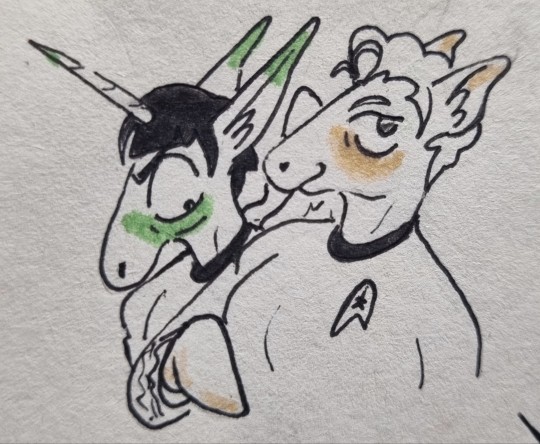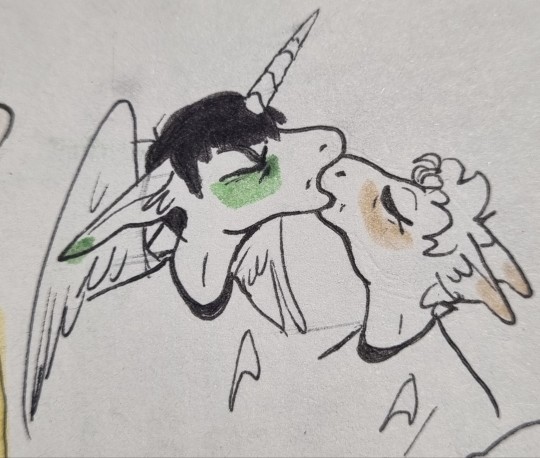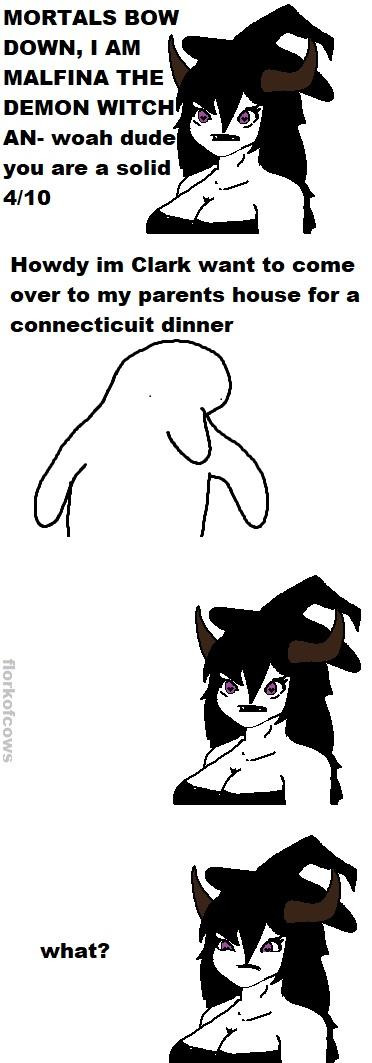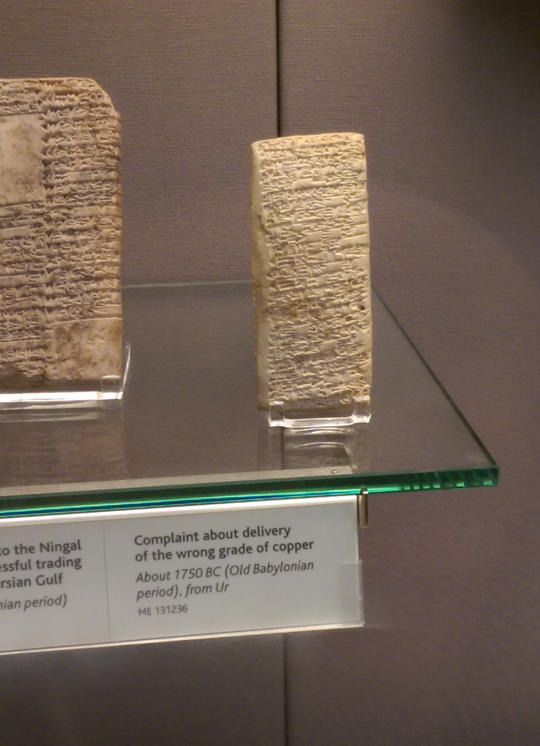#I didn't look out actual horse references out of respect of real horses
Text

I drew them as anthropomorphic horses based on their pony designs. Spock horse. Sporse?


My sincere apologies.
#I didn't look out actual horse references out of respect of real horses#someone should stop me#my next post will be normal i promise#star trek#star trek tos#star trek the original series#spock#s'chn t'gai spock#james t kirk#jim kirk#captain kirk#spirk#spock x kirk#horse#anthro#i guess#fanart#art#traditional art#horse Mccoy would be white so his terrifying blue eyes would stick out more#damn you limitations of traditional art#also technically Spock is an alicorn not a horse#target audience: me#self indulgent post#should I delete this
87 notes
·
View notes
Text
My Good Omens Season 3 fan project
I spent most of my day fleshing out "my 3rd season of good omens" and I have to say I'm pretty damn proud of it. It's structured in 6 episodes and all.
I don't know if I'll have the time and patience to type everything. I wrote it on a notebook. I'd actually prefer to make a podcast or maybe a video narrating everything, but I guess people prefer to go to AO3 or something like that...
Some "spoilers" of my headcanon:
* hilarious scene of Crowley doing confession in a cathedral in Oxford to get a chance to talk to the priest (Crowley wears a full body raincoat and extra padded boots).
* Aziraphale starts the story overseeing the 7 angels practice playing their trumpets (they need to be ready for when the 7th seal is broken) as part of the insufferably useless corporate routine the metatron imposed on him. Another one is supervising incense production. Lots of incence in the book of revelation.
* there's a crown court hearing/ trial taking place at Oxford (that's a real thing and real name, I didn't make it up) that moves the plot forward. There are 12 jurors as a reference to the 12 apostles (that's the real number of jurors for these cases). The trial at Oxford triggers flashbacks to Crowley's trial. Back in Crowley's trial, Aziraphale tries to testify in his favor but the heads of Heaven, especially the metatron, subvert everything he says to make Crowley (Starmaker back then) look guilty. An angel - none other than Pre-Fall Dagon - comes in as accusation witness, Crowley says hey, you rebelled too! And dagon says they were a special spy infiltrated under superior orders and all their actions will be pardoned in exchange for them testifying. Dagon's testimony seals Crowley's destiny, and later, once all the rebels have been sentenced, Heaven sentences Dagon to hell anyway claiming the deal was invalid because of some ridiculous technicality. Season 1 was a chase story, season 2 was a mystery story, season 3 is a trial story (not exclusively, of course, but it's important. The whole theme of the second coming is Christ judging everyone, one by one. There's no escaping the "judgement" theme here) (I'm a lawyer so I'm pretty confident to approach this theme).
* did you know that Milton Keynes was designated as a new town in 1967? Do you know what else happened in 1967 in season 1? And do you know that both Crowley and Aziraphale took credit for Milton Keynes to their respective head offices, in the book? Put 2+2 together and we get an amazing flashback including Aziraphale and Crowley's first ever dinner at the Ritz! (for reasons I already explained in another post, no, they don't kiss before the s2 scene, so hold your horses).
* possibly a flashback of Aziraphale and Crowley during the wars of religion in Wales that serves to showcase some of their conversations trying to understand Christ's message and why humans misanderstand him so much. It's included for a number of reasons: we need to have something in Wales for Michael Sheen (now that David Tennant got to do his Scottish accent!) plus they really should talk about how ironic and tragic it is that so many people have killed each other over religious differences concerning Christ's message of peace and love among all persons and all peoples. Including the commandment of not killing each other. Seems to have gone right past people somehow. (this flashback also helps to give us some lighthearted Aziracrow early on, because Aziraphale and Crowley only really hit it off again by the end of episode 3 and only really get back together in episode 4).
* a new human character named Abel J. Ryuss has an important role as well. His full name is Abel James Ryuss. We get some 4 ou 5 new human characters that are important to the plot.
* Crowley kind of calls attention on a new human prophet and "outs" him as a prophet by accident and the dude ends up becoming a famous influencer - aka the modern equivalent of a prophet.
* the story begins with 4 out of 7 of the apocalypse seals already broken (aka the 4 riders of the apocalypse). When the 5th seal breaks, the dead arise. When the 6th seal breaks, in episode 5, Gabriel and Beelzebub return. But they're foreshadowed in episode 4 by the appearance of a blue bird with a fly flying around it in a tree in the background.
* the trio of angels: Michael, Uriel and Saraquiel each makes very different choices and have very different endings. One is irrelevant, one is killed and one ends up as the supreme archangel.
* heaven has at least 3 different factions with different agendas working to their own ends simultaneously. Hell has 2.
* catastrophical destruction followed by huge battle.
* In the end Gabriel and Beelzebub become consultants.
* careful with those to claim to speak for God.
* a marriage at south downs - and it's not Crowley and Aziraphale's! It's another couple we love. Aziraphale and Crowley needed a reason to go to south downs in the first place. Then they can take a walk and stumble upon a lovely cottage that just happens to be for sale.
#good omens#crowley#ineffable husbands#aziraphale#aziracrow#ineffable dumbasses#good omens thoughts#good omens spoilers#azicrow#good omens headcanon#good omens season 3 headcanon#good omens 3#HEADCANON
23 notes
·
View notes
Text
Heya Vtubers! It's nice to see people moving over from twitter - as much as people joke about "amping up the cringe" to drive people off, tumblr's more welcoming than you're expecting!
My ask box is definitely open if people have questions and I've seen some help starter guides floating around, and figured why not make my own too?
This isn't about how to use tumblr though it's about a lot of the common in jokes/memes that float around. Tumblr culture works very different than Twitter culture - memes dont really come and go, they stick around. Part of this is because you can reblog posts multiple times - and yes I know good memes stick around on twitter too, but it's a very different slowness to Tumblr meme culture
This does in fact mean someone can and will flood your dashboard with repeats of the same post and yes I'm looking at you reg
We've got some silly weekly traditions like out of touch thursday, wizard wednesday, and fingers in his ass sunday and yes people Do re-reblog that shit every week. If you tell me "I like your shoelaces" I will, very stupidly, blurt out the first thing that comes to mind and it will be "Thanks I stole them from the president"
The rest shall be under a readmore because this got Very long. It's not all the memes but its a lot of my favorites that I see pretty often.
the "color theory" post


if someone says anything about color theory especially if they mentioned "children's hospital" they're likely referring to this
The skeleton wars preceded my entry onto tumblr but that was in fact a thing learn your history
Mishapocalypse was also a thing, but more relevant, is our newest holiday, Nov 4-5th

I hate to say you had to be there, but it really was a sort of manic energy you can experience in the moment. It didn't matter if you liked supernatural, destiel, sherlock, or anything, we All held hands on Nov 5th

The queen's death came mildly close, but there won't another queerbait like it. This is also the origin of the superhell meme for my fellow LGBT+

Speaking of the queen, tumblr had been waiting to celebrate her death for a Long time. People will be respectful about how her death affected shit for everyone, but they aren't going to be respectful towards her or the royal family here. We had our crab raves ready for Years before she finally kicked the bucket.
We did enjoy the sexyman polls btw, even if you twitter people were silly enough to host them offsite
"Daily Dracula" isn't just tumblr specific, but it is very popular here. It's an email newletter that sends snippets of the classic novel in real time with dates from the book.

horse plinko.

I don't have room for the entirety of the Connecticut Clark saga but its a lovely comic and Cark and Malfina are All our blorbos

You may be familiar with tumblr celebrating the Ides of March (also a very real holiday respect our traditions), so heres another history meme we've got. If people joke about the value or copper or Ea-nasir, theyre referring to this post

Around 2017, there was a time where nazi, pedo, terfs and other sorts of shit blogs were taken over by someone using Toy Story's Woody as an icon and Howdy Pardner as a blog title. Eventually the whole thing got out of hand but whoever originated Woody's Roundup was pretty funny

Popularity on tumblr is hard to gauge, but theres a few blogs out there that just Everyone knows.
We know Sixpenceee for the "Sixpenceee Heals" incident among others,
we know about thejorie's Three Weed Smoking Girlfriends,
we had bone stealing witches at one point, but not sure if they're still hanging around

thecybersmith is well known for being the Human Pet Guy among other incredibly weird takes. i think they also went to twitter but they've got a Reputation here for sure
we are Very Aware about John and Hank Green due to an incident when editing other people's posts was a thing, and people edited one of John Green's posts to be very nsfw. There's a bit of a back and forth on this one whether it was actually funny or not, but this incident did drive them off tumblr which makes John Green's recent string of tweets Fascinating




The wizard blogs are special to us, please be polite to them and pay your wizard tithes on time. I don't listen to the wizard council though, I'll cast transmute idaho if I want to.

People are sometimes really bad about reading the op of a post, and one-time-i-dreamt is well known for jumpscaring people with posts that seem like almost real encounters until you realize the blog title means this was something someone dreamed
There's definitely more but i woke up in a cold sweat at 3:30 am to write this and its now 5am so I'll leave it at that. add your favorite tumblr specific memes if you'd like.
tumblr loves to beat a dead horse (or put it in a plinko) so dont be afraid to reblog old jokes, or put a new spin on an old joke, or be like Reg who regularly reblogs the "i control the paladins" tiktok fifty times in a row when people get a bit too weird in their notes (not an exaggeration. I learned tumblr hotkeys for you my beloved mutual)
3 notes
·
View notes
Text
Chapter XVIII
The Frowe (Freyja)
The Frowe is probably the best-known and most beloved of the goddesses today. As mistress of magic and goddess of sexual love, she kindles the imagination and sparks the heart. Whereas that other great goddess, Frija, is wholesome and safe, the Frowe is sweet, wild, and dangerous. Though Fro Ing is her twin brother and their mights mirror each others', the two of them show that might forth in very different ways.
Her name, Freyja or the Frowe, is a title meaning "Lady". Though she has many other names in the Old Norse sources, it is not known which of them (if any) was her true name. In Scandinavia, the title was associated so strongly with the goddess that it, like her brother's title "Freyr", was dropped wholly from ordinary human use and preserved only as a name; but in Germany, where she either was not known or was known by a different name, the cognate word "Frau" has continued in human use to the modern day. To the Scandinavians, however, there was apparently one "Lady", and one "Lord", whose titles could be used by no one else (it was only towards the end of the Viking Age that the word "húsfreyja", "house-Freyja", came into use for the lady of the house; this may have stemmed from skaldic kennings, in which a woman might for instance be called "Freyja-of-necklaces", or, since the form húsfrú also appears, have been borrowed from the corresponding German title). These titles clearly show the love and respect which our forebears felt towards the Frowe and her twin. In modern times, it has often been suggested that our "Lady" and "Lord" are the original pair whose memories survived in Northern European folklore to be called upon as the Wiccan Lady and Lord today. This fits well with much of what we know of the Frowe and Fro: as well as being sister and brother, they are also lovers, as is spoken of in Lokasenna. The possibility of a likeness between Freyr and the Horned One is also mentioned in the chapter on "Fro Ing".
The main difference between the Frowe and the Wiccan Lady is that the Frowe is not motherly in any way. Because she is the best-known Germanic goddess, folk have often thought of her as possibly being a Germanic reflection of the Mother-goddess archetype. Unlike Frija, however, we never see her giving fruitfulness to folk, nor does she appear in a motherly way to either deities or humans. Only once does she appear as a patron of childbirth: in Oddrúnargratar, the childbirth-blessing calls on "kind wights, Frigg and Freyja and many gods". However, this poem is generally thought to be among the youngest of Eddic lays; Hollander actually suggests that the invocation to "Frigg and Freyja" is a deliberate archaism put in to give the poem a heathen flavour (The Poetic Edda, p. 279). Although Snorri tells us that the Frowe has two daughters, both their names (Hnoss and Gersimi) are ordinary words for "treasure". In fact, they are mentioned only twice in skaldic poetry, where actual treasures are called "Freyja's daughter". If it is not the case (as it may well be), that these references simply speak of the belief that gold comes from the Frowe's weeping and treasure is therefore "her daughter", these maidens may be understood as embodiments of her might as a goddess of wealth; one might perhaps ask the Frowe for "the love of her daughters".
To the Norse, Freyja was a goddess of riches, whose tears fell to the earth as gold and whose most common appearance in skaldic poetry is in kennings for "gold". Although many of the god/esses are givers of wealth, she seems to be first among them. Here we see one of the ways in which the Frowe and Fro Ing work differently: the riches he gives are those of the fruitful fields and beasts, while those she gives are the worked gold - we might say now that Fro Ing is the god to call on to bring the harvest of long-term investments about well and to look after real estate deals, while the Frowe is the goddess to ask about cash-flow.
The Frowe is probably best-known, however, as a goddess of love and sexuality. The etin-maid Hyndla says to Freyja "(You) ran, ever-longing, after Óðr, you let many creep beneath your fore-skirt - atheling-friend, you leap about at night like Heiðrún among the goats" (Hyndluljóð 47). Loki says that she has slept with "all gods and alfs in the hall" (Lokasenna 30), which seems to be true. Unlike Frija and Wodan, to who their chosen humans are children or foster-children, the Frowe's heroes are her lovers; the Eddic poem Hyndluljóð gives us a very clear description of her beloved Óttarr, whom she has changed into a boar which she rides to the rock-hall of the giantess Hyndla. This sort of "nightmare-riding" is typical for witches throughout the Germanic world. Unlike the men of later folk-tales, however, Óttarr is not only apparently willing to be ridden, but gets some good from the faring - the account of his lineage, which he must use to win his inheritance. Still, the Frowe's love is as dangerous as it is wildly exciting: Hyndla says that Freyja is riding Óttarr on his "slain-faring" (í valsinni), and since the etin-woman sees clearly otherwise, we may suspect that the goddess' lover was not long-lived.
The story of Óttarr, who built a harrow for Freyja and reddened it with blood until the holy fires (or the heat of Freyja's might) had turned the stones to glass, also suggests that the Frowe was not only worshipped by women, but had her own given godmen. Like the gyðja who was Freyr's wife in Gunnars þáttr helmings, these men may well have been seen as the Frowe's husbands or lovers. Some of the mysterious deaths of Yngling kings, such as that of Agni, who was strangled with a necklace by his wife, or Aðils, who, touched by a witch's magic, fell off his horse at the dísablót (goddesses' blessing - see "Idises"), also suggest the possibility that these Ing-descended kings died as holy gifts to Freyja.
Snorri tells us that Freyja is particularly fond of love songs (mannsöngr), of a type we know to have been outlawed in Iceland even before the conversion; and the pages of heathen publications are often brightened by love-songs written for Freyja. Such a song of your own is a fitting gift for her: one copy might be written out in runes and burned for her while you read the other aloud to her.
It is strongly suspected that the Frowe's sexual character led to the suppression of much of her lore by christianity. however, some pieces did survive, though in a diluted and moralizing form. The best-known of these is the tale (from Sörla þáttr in Flateyjarbók) of how she saw four dwarves forging a necklace (the Brísingamen) and traded four nights of her love for it. Alice Karlsdóttir reads the tale thus:
The story is usually told to demonstrate Freyja's 'immorality' or bawdy humour. This always seemed rather unfair to me. After all, when writers discuss Odin and how he slept with Gunnlod on three nights in order to win the mead of poetry, they praise his efforts at winning wisdom, but when Freyja, a goddess, does pretty much the same thing, they say, "What a shameless hussy!"
Freyja's necklace is not, of course, just a pretty piece of vanity, but rather a powerful symbol of the goddess' powers of fertility and life. Giants are continually trying to win or steal Freyja for themselves, not just because she's a good lay, but because her powers contain the essence of the life force itself and sustain the well-bring of Asgard and the rest of the worlds. the story of how Freyja got the Brisingamen is a story of her quest for wisdom and power, every bit as much as Odin's adventures are...
One of Freyja's powers seems to be a mastery of material manifestation, the infusing of the physical world with the spiritual. Freyja not only masters the senses, she revels in them and shows that physical existence itself is a wondrous thing. I always sort of imagined that the dwarves didn't create the necklace until after Freyja slept with them, that their intercourse was necessary to inspire the dwarves to be able to make the Brisingamen in the first place. Freyja, on the other hand, discovers the powers of the material world and how to control and shape them.
The goddess' necklace or girdle is an emblem that goes back to the Stone Age, when slender amulets of schist, given human form only by the careful carving of necklaces, were carried about (Gløb, Bog People p. 159). As mentioned in "The Stone Age", amber necklaces of a size only a goddess could have worn were being given to bogs at the same time. The Bronze Age kneeling goddess-figurine who drives a small ship with a snake leashed beside it wears only a necklace and a string-skirt; the same is true of the little female acrobat/dancer from the same period. The huge Swedish gold collars of the Migration Age (discussed in the historical chapter), were clearly also holy, and by this period it is quite possible that they could have been given specifically to the Frowe, although god-figures with collars carved on their necks have also been found. The necklace is the sign of the world's ring; Freyja's winning of the Brisingamen is one of the strongest reasons to think of her as an earth-goddess like her mother Nerthus, and therefore, though there is nothing in the Norse sources to suggest it, perhaps also being one of the goddesses who makes the world fruitful. It is certainly the sign of her power. We do not know what it actually looked like: the name "Brísingamen" can either be read as "the necklace (or girdle) made by the fiery ones (Brísings, presumably the name of the dwarves)" or as "the fiery necklace (or girdle)". We know that gold is called fire in kennings, so that the Brísingamen is likeliest to have been made of gold, though it is often pictured in modern times as being amber or at least set with amber. In Úlfr Uggason's poem Húsdrápa, the Brísingamen is called hafnýra, "harbour-kidney", a kenning which may also hint that amber was a part of the necklace, since amber was normally gathered along the seashore. The workings of the four dwarves might hint at a four-ringed collar, or a four-stranded necklace - especially since, seen on a level plain, the cosmos also has four concentric rings (the Ases' Garth, the Middle-Garth, the sea around the Middle-Garth, and the Out-Garth - see "Worlds"). The Frowe's necklace would then be the embodiment of her might through all the realms. A small Swedish pendant from Östergotland (late Viking Age) is often thought to represent Freyja: it shows a remarkably large-breasted woman wearing a four-layered necklace and seated inside a ring.
As the bearer of fiery life-might, the Frowe is greatly needed by the other god/esses; etins often seek her in marriage, as was done by the builder of Ase-Garth's walls and the giant Þrymr, who stole Þórr's Hammer to use it as a bargaining point in getting her.
The Frowe is first thought to have come among the Ases as the witch Gullveigr ("Gold-Intoxication"), whose fate started the war between the Ases and the Wans: "when Gullveigr was studded with spears and burned in Hár's hall; thrice burned, thrice born, often, not seldom, but yet she lives" (Völuspá 21). Here we see what is clearly a Frowe-initiation similar to that of Wodan's hanging on the tree: while he is hanged and stabbed, she is stabbed and burnt, each of them slain by the means which is holiest. Just as Wodan won the runes, the Frowe came forth with the full lore of her own seiðr: "Heiðr hight she, when she came to houses, spae-wise völva, she knew magic; she worked seiðr as she knew how to, worked seiðr, playing with soul - she was ever beloved to wicked women" (Völuspá 22). The name "Heiðr" means either "the Glorious/Bright One" or "the Heath-Dweller": we can see her wandering freely through heath and house, glowing with the seething fires of her threefold burning and rebirth. Heiðr is seen in modern times as the "older woman" aspect of Freyja, with the fiery might of her gold and sex sublimated into the wisdom and magical might of the witch. The stone we associate with her now is jet, and the colours are black and white interwoven so that they look gray from a little way off. Eiríks saga ins rauða mentions that the seeress was fed a meal of the hearts of several sorts of animals; as Heiðr is the great völva (even as Wodan is Fimbulþulr, the great thule), it is thought today that hearts are the meat which is holiest to Heiðr.
Snorri also tells us in Ynglinga saga that Freyja taught the art of seiðr to the Ases; Thorsson sees this as an exchange whereby Freyja learned the runes from Óðinn and he learned seiðr from her. In any case, the situation is, again, comparable: as Wodan teaches the craft of the runes after his initiation, so Freyja teaches the skill of seiðr after hers - not only to the Ases, but, as Völuspá suggests, to humans as well.
The Frowe is married to a god called Óðr - the noun from which the adjectival "Óðinn" is derived. The folklore of the Wild Hunt suggests that "Wod" was an older form of the name *Woðanaz; de Vries also compares the Óðr-Óðinn to the other surviving pair of noun-adjective forms, Ullr-Ullinn ("Contributions to the Study of Othin"). There is little doubt that Óðr and Óðinn were the same god, although this identity seems to have been forgotten by the end of the Viking Age; it is probably very old. The wedding between Óðr and Freyja is, at the least, a very open one: the way in which the Frowe is sought as a bride by etins suggests that she is thought to be effectively single. Sörla þáttr describes her as Óðinn's mistress, rather than his wife. The two of them clearly work together - they mirror one another in many ways and share many of the same realms - and both being quite sexual deities, it would be surprising if their relationship was not shown forth as a sexual one. However, the Frowe seems to be too independent to tie herself to any single male for long; though she wandered weeping after Óðr when he left her, there is no doubt that sexual faithfulness was never part of the arrangement.
The Frowe is also a battle-goddess: one of the names of her hall is Folkvangr ("Army-Plain"), and there "Freyja rules the choices of seats in the hall: she chooses half the slain every day, and Óðinn has half". It is not sure whether by "choosing the slain", the Grímnismál speaker meant this in the usual sense (as when used for the walkurjas, Wodan, and Hella) of choosing who among the living warriors shall be slain in that battle, or whether it means that the Frowe gets her choice of those among the fallen who she wants for her hall. In either case, she is certainly a goddess of death and specifically the battle-dead: the men she wants are clearly the best of heroes. What she does with them is never told to us, whether they fight beside the einherjar at Ragnarök or stay with Freyja, who may survive the battle (in Ynglinga s. ch. 8, Snorri tells us that "Freyja then kept up the blessings, for she alone lived after the gods", though since he has euhemerized them all and given them very different deaths from those they meet at Ragnarök, this may not be a reliable indicator). As seen in the tale of Gullveigr, she is also a cause of strife as well: wealth and women were two of the most common causes for fighting among the Germanic folks. The two chief social roles of women in the Icelandic sagas were as frith-weaver and strife-stirrer: Frija embodies the first, the Frowe the second. Here, the Frowe and Fro Ing complement each other rather than working in the same way: the Eddic poem Grottasöngr shows how the two, strife and frith, need each other. When Fróði harnesses the etin-maids Fenja and Menja to turn a magical mill, they grind out gold and frith and happiness; but instead of letting them rest, he tries to keep them working without pausing longer than it takes to sing a lay. Then the scales tip too far: the women become angered and grind out battle and Fróði's death, and the balance is evened again. The Frowe stirs up Fro Ing's frith; Fro Ing stills her strife; thus challenge and rest are balanced out.
According to Snorri, the Frowe's hall is also called Sessrumnir, "Roomy-Seated" - which it would need to be as a hall of the dead. As is not hard to imagine, the sexes seem to mix freely in the Frowe's realm, warriors and young women alike: when Egill Skalla-Grímsson's daughter Þórgerðr tells of her intention to starve herself beside her grieving father, she says that she will take no food until she sups with Freyja.
Like her brother, the Frowe has the swine as a holy animal, and rides on a gold-bristled boar (hers is called Hildisvín, "Battle-Swine") which was made by dwarves. The Yule boar is holy to her, as to him. One of the Frowe's own by-names is Sýr, "Sow", which suggests not only her fruitfulness and sexuality, but her more frightening side: the swine is, after all, a carrion-eater, and sows are proverbially known for eating their own piglets at times.
Like Frija, the Frowe travels through the worlds by putting on a falcon-hide and faring forth in that shape. Though none of the myths show her actually using it - we only know of it because she lends it to Loki - the falcon seems to be the womanly match to the manly eagle (a shape taken by Wodan and, quite often, by etins). This shows her swift-faring through the worlds; the falcon is clearly a holy bird of hers, in her most active shape when she is not only fiery, but ærial. Some of the birds of prey which appear so often in Germanic art may be falcons rather than eagles, but our forebears' art was so stylized that there is no way to tell which is which; only the hooked beaks distinguish birds of prey in general.
The Frowe is also well-known to have a wain which is drawn by two cats. Every so often the question of what sort of cats these were, or whether they were actually felines and not some other creature, comes up. Grimm mentions that the Old Norse word fres "means both he-cat and bear, it has lately been contended, not without reason, that köttum may have been subsituted for fressum, and a brace of bears have been really meant for the goddess" (Teutonic Mythology, II, p. 669). It has also been suggested several times that the image of Freyja in her cat-drawn wain was borrowed from the southern Cybele, whose chariot was drawn by lions. There is also a special connection between seiðr and cats: the seeress in Eiríks saga ins rauða is described as wearing catskin gloves, which has spurred many people to hope that the Old Norse word köttr, "cat", did not really mean cat. Alternate suggestions have included bears (gib-cats), hares, and various sorts of ermine- and weasel-type creatures. However, wild felines such as the lynx have been native to Scandinavia at least since the earliest human settlements, and the first skeletal evidence of house-cats dates from the earlier part of the Iron Age (Scandinavian Saga, 131). Further, the burial goods of "Queen Asa" (the Oseberg queen) include elaborately carved vehicles (generally thought to be for cultic processions) on which cat-images are carved. In one case, the sledge-posts are unquestionably cat-heads; the end panel of the wagon shows a repeated picture of a cat who is apparently fighting or dancing with a snake, while either shielding her eyes with one paw or just revealing them (perhaps to awe the snake by her gaze?). These cats are probably house-cats or small European wildcats, as they do not have the tufted ears of the lynx. A little amber cat-figurine was also found lately in the archaeological excavations at the late Viking-Age site on Birka. All of this, particularly the cat-head posts from Oseberg, suggest very strongly that there is every reason to think that the belief is native rather than foreign, that Freyja's cats are indeed house-cats - and so were the seeress' gloves. No names for these cats have survived in any sources, but in her book Brisingamen (which is highly recommended to all Ásatrúar, especially those interested in Freyja), Diana Paxson suggests the names "Trégull" ("Tree-Gold", or amber) and "Býgull" ("Bee-Gold", or honey) for them. Some will be amused, and others appalled, to note that certain less-reliable books on Norse heathenism are already solemnly reporting these fictional names as part of authentic Teutonic tradition...
The Frowe herself was known by other names in Scandinavia: Snorri gives us the names Hörn (which is etymologically tied to "flax"), Sýr ("sow"), Gefn ("giver"), and Mardöll ("Sea-Brightness" - another name which may refer to amber, or else to gold, which is often called "fire of the sea"). These names are likeliest to have been local titles for either the Frowe or other goddesses who were so like her that it made no difference.
The Frowe's stone is amber, a connection which may go back to early days. Amber is especially beloved by Northern folk; it is "the gold of the North". In our forebears' time, necklaces of amber were probably a status symbol as much as anything; and even today at Teutonic rites, one can often see women (and occasionally men) hung with as many strands of amber as they are able to buy. Other stones which the name "Brísingamen" and the Frowe's flame-being suggest are fire agates and fire opals; gold is clearly her metal, if you can get it.
The elder-tree (whose very name means "fire") is especially close to her; yarrow and dill, as traditional "witches' herbs" also belong to her. Her flower is the rose, especially the Northern European wild rose or "dog-rose". One Northern German church is supposed to have been built at "Freyja's spring"; when the church was rebuilt after the last World War, the roots of the dog-rose which had grown beside it were shown to be over a thousand years old. The legend of "Freyja's spring" may have been a romantic product of the eighteenth or nineteenth century, but the flower itself surely shows her being, being both the sweetest and the thorniest of blooms.
The Frowe is especially a goddess of women who do as they will and love as they will without worrying about social constraints or anything else. More than any other goddess, she shows the right of women to rule over their own bodies, to love - or not love - as they choose. Indeed, according to Þrymskviða, it was easier for the Ases to get Þórr to put on women's clothing and go into Etin-Home as a bride than for them to make Freyja wed against her will!
The necklace is the sign which is traditionally that of the Frowe's might, though there is no one picture of it that stands as "her symbol". In A Book of Troth, Thorsson suggests that "Freya's Heart (the basic heart-shape) is the sign of the blessings of the goddess Freya, and is the symbol of those given to her mysteries" (p. 112). This is extrapolated from the reading of this symbol as showing the female genitals and/or buttocks: as the stylized picture of womanly sexuality, the heart (with or without the phallic arrow piercing it), is clearly fitting to the Frowe.
It is thought in modern times that the Frowe likes sweet drinks, especially berry liqueurs and German wines of the Auslese, Beerenauslese, and Trockenbeerenauslese class. One liqueur in particular, Danziger Goldwasser (which has actual flakes of high-karat gold foil in it), is felt to be especially fitting to her.
Contributors
Stephan Grundy, "Frigg and Freyja"
Alice Karlsdóttir, from "Freyja's Necklace", Mountain Thunder #10, pp. 21-22.
Diana Paxson (esp. Heiðr and cat-names)
3 notes
·
View notes